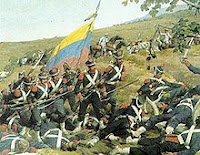Assignment One
Activity #1
 |
| Map of Venezuela |
The country I have chosen for my cultural portfolio is Venezuela , a country at the top of South America, whose entire northern boundary is the Caribbean Sea . When I was a child, I learned that my favorite Chicago White Sox player, a shortstop by the name of Alfonso “Chico ” Carrasquel, was from Venezuela Chico Venezuela has the largest oil reserves in the Western Hemisphere and that politically, its President, Hugo Chavez, is not well liked by the U.S. Venezuela
Activity #2
 |
| The Flag of Venezuela |
1) As a definition of culture, I would suggest it means all the aspects of human activity within the confines of time, place, and resources that a given social group of humans create for themselves. That includes language, economic activity, religious or spiritual beliefs and practices, social stratification and organization, norms and values, marriage and family life, geographical resources and foods available for consuming, customs, and leisure activities and arts. A society’s cultural beliefs and practices, I think, determine the course and quality of life for each member of that society. As such, I believe it is the underpinning that helps individual members of that group survive and, hopefully thrive.
Placed alone on a small desert island, humans by themselves would likely lose the structures as well as the know-how to survive for long.
 |
| Plaza de Altamira, Caracas |
(2) The 3rd Edition of the Oxford Encyclopedia English Dictionary provides this definition: “(2a) the customs, civilization, and achievements of a particular time or people, or (2b) the way of life of a particular society or group. (1996, p. 347) My definition does correspond to the dictionary’s, though I have tried to include more specifics.
(3) Like most of us, much of my culture was the product of my parent’s experience. I was born into a family in the Midwest of the United States Canada
 |
| Simón Bolívar |
(4) As mentioned in the first activity of this portfolio, I know that Venezuelans play American baseball, that oil is their major export, and that their President currently is Hugo Chavez. I’ve also learned in this class that their national hero is Simón Bolívar who was their father of independence, and that their political history is rather mixed with elements of disruption—coups and dictatorships—as well as years of calm and democratic government. In the 16th century, Spanish colonial explorers arrived to search for gold and other riches, while missionaries came to convert the Amerindian natives and build Roman Catholic missions and churches. With them they brought their language and governmental forms which they imposed on the native populations. This history is pretty typical of Spanish colonization in the Western Hemisphere of all the Americas Venezuela
_______________________________________
Reference
The Oxford New York : Oxford University

























